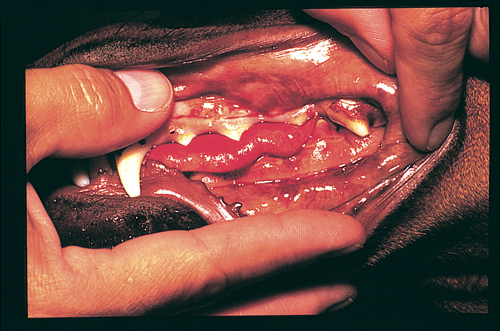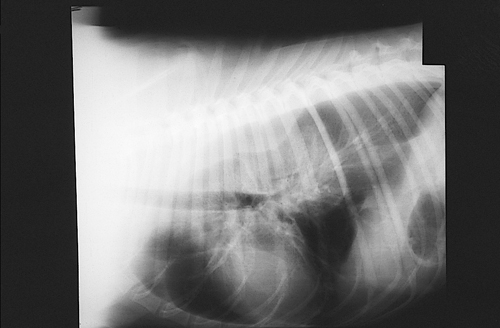Difference between revisions of "Small Animal Emergency and Critical Care Medicine Q&A 22"
Ggaitskell (talk | contribs) |
|||
| (3 intermediate revisions by the same user not shown) | |||
| Line 1: | Line 1: | ||
| + | {{Template:Manson | ||
| + | |book = Small Animal Emergency and Critical Care Medicine Q&A}} | ||
| + | |||
| + | |||
[[Image:ECC 22a.jpg|centre|500px]] | [[Image:ECC 22a.jpg|centre|500px]] | ||
<br> | <br> | ||
| Line 14: | Line 18: | ||
*previous bleeding episodes (e.g. following spaying or castration) which might indicate a coagulation factor deficiency, | *previous bleeding episodes (e.g. following spaying or castration) which might indicate a coagulation factor deficiency, | ||
*recent use of medications which could cause platelet function disorders, vitamin K malabsorption or immune-mediated thrombocytopenia. | *recent use of medications which could cause platelet function disorders, vitamin K malabsorption or immune-mediated thrombocytopenia. | ||
| − | |l1= | + | |l1=Anticoagulant Rodenticide Toxicity |
|q2=What diagnostic tests are indicated? | |q2=What diagnostic tests are indicated? | ||
|a2= | |a2= | ||
| Line 22: | Line 26: | ||
Thoracic radiographs are indicated to determine the source of the hemoptysis. | Thoracic radiographs are indicated to determine the source of the hemoptysis. | ||
| − | |l2= | + | |l2=Coagulation Tests |
|q3=Your initial diagnostic tests reveal an ACT of 3 minutes and a normal platelet estimate. What initial treatment would you implement? | |q3=Your initial diagnostic tests reveal an ACT of 3 minutes and a normal platelet estimate. What initial treatment would you implement? | ||
|a3= | |a3= | ||
| Line 29: | Line 33: | ||
Treatment should consist of vitamin K1 therapy (loading dose of 5 mg/kg s/c then 2.5 mg/kg/day p/o), plus supportive care including oxygen supplementation if tachypneic or dyspneic, and whole blood or plasma | Treatment should consist of vitamin K1 therapy (loading dose of 5 mg/kg s/c then 2.5 mg/kg/day p/o), plus supportive care including oxygen supplementation if tachypneic or dyspneic, and whole blood or plasma | ||
replacement if indicated. | replacement if indicated. | ||
| − | |l3= | + | |l3=Anticoagulant Rodenticide Toxicity |
| − | |||
</FlashCard> | </FlashCard> | ||
| − | + | {{#tag:imagemap|Image:Next Question.png{{!}}center{{!}}200px | |
| + | rect 0 0 860 850 [[Small Animal Emergency and Critical Care Medicine Q&A 01|Small Animal Emergency and Critical Care Medicine Q&A 01]] | ||
| + | desc none}} | ||
[[Category:Small Animal Emergency and Critical Care Medicine Q&A]] | [[Category:Small Animal Emergency and Critical Care Medicine Q&A]] | ||
Latest revision as of 22:54, 10 October 2011
| This question was provided by Manson Publishing as part of the OVAL Project. See more Small Animal Emergency and Critical Care Medicine Q&A. |
An 11-month-old, male Doberman Pinscher is presented with a 3-day history of coughing. In the past few hours he has started to produce frank blood and blood clots when he coughs.
| Question | Answer | Article | |
| Based on the clinical presentation, what historical questions should be asked of the owner? |
|
Link to Article | |
| What diagnostic tests are indicated? | A coagulation profile is indicated, including a platelet count, PTT, OSPT and assays for fibrin degradation (or split) products and fibrinogen. An ACT and platelet estimate on a blood smear may help to indicate a coagulopathy. Thoracic radiographs are indicated to determine the source of the hemoptysis. |
Link to Article | |
| Your initial diagnostic tests reveal an ACT of 3 minutes and a normal platelet estimate. What initial treatment would you implement? | Rodenticide toxicity is suspected. Treatment should consist of vitamin K1 therapy (loading dose of 5 mg/kg s/c then 2.5 mg/kg/day p/o), plus supportive care including oxygen supplementation if tachypneic or dyspneic, and whole blood or plasma replacement if indicated. |
Link to Article | |

